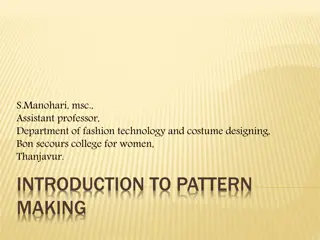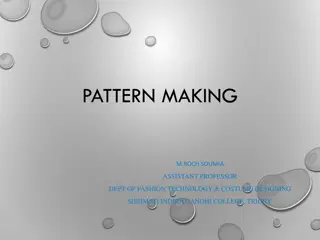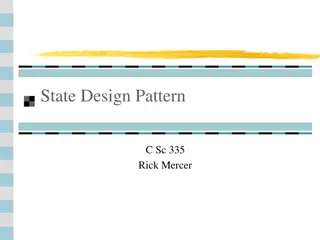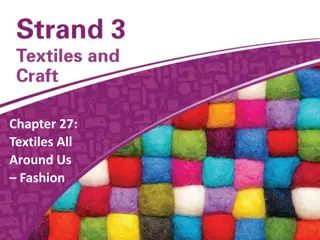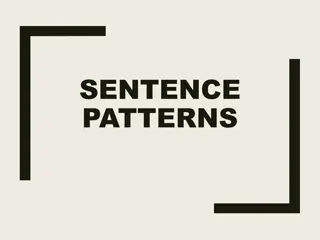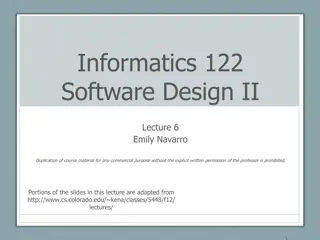Methods of Pattern Making in Fashion Design
Pattern making in fashion design involves three main methods: drafting, draping, and flat paper pattern making. Drafting consists of taking measurements and marking construction lines on paper to create patterns, while draping involves shaping fabric around a form to visualize the garment's design effect. Tools like tape measures, scissors, and rulers are essential for pattern making. Both drafting and draping offer unique advantages in creating patterns for garments.
Download Presentation

Please find below an Image/Link to download the presentation.
The content on the website is provided AS IS for your information and personal use only. It may not be sold, licensed, or shared on other websites without obtaining consent from the author.If you encounter any issues during the download, it is possible that the publisher has removed the file from their server.
You are allowed to download the files provided on this website for personal or commercial use, subject to the condition that they are used lawfully. All files are the property of their respective owners.
The content on the website is provided AS IS for your information and personal use only. It may not be sold, licensed, or shared on other websites without obtaining consent from the author.
E N D
Presentation Transcript
METHODS OF PATTERN MAKING S.Manohari, msc., Assistant professor, Department of fashion technology and costume designing, Bon secours college for women, Thanjavur.
Methods of Pattern Making Methods of Pattern Making Pattern making involves three methods- Drafting Draping Flat paper pattern making
Drafting Drafting
Drafting Drafting It involves measurements derived from sizing systems or accurate measurements taken on a person, dress or body form. Measurements for chest, waist, hip and so on, and ease allowances are marked on paper and construction lines are drawn to complete the pattern. Drafting is used to create basic, foundation or design patterns.
MEASUREMENTS MEASUREMENTS Bust measure just under the arms around the fullest part of chest. Waist measure around narrowest part of torso. High Hip measure 6 inches [15.5 cm] below waist around the hips. Back-waist length measure from nape of neck to waist level Shoulder length measure shoulder from ball socket to side of neck. Armhole depth measure from nape of neck to under arm level. Back width measure from armhole to armhole across shoulder blades. Neck measure around base of neck.
Tools use for Drafting Tools use for Drafting A: Tape Measure B: Seam Ripper C: Fine Point Sharpie Marker D: Tracing Wheel E: Rotary Cutter
Continue.. G: Tracing Paper F: Fabric Scissors H: Scotch Tape I: Clear Rulers J: Right Angle K: Curved Rulers
Draping Draping
Draping Draping It involves the draping of a two dimensional piece of fabric around a form, conforming to its shape, creating a three- dimensional fabric pattern. Ease allowances for movement are added to make the garment comfortable to wear. However, it is more expensive and time consuming than flat pattern making. Draping can be made on a Human body or on a stand. Advantage of draping is that the designer can see the overall design effect of the finished garment on the body form before the garment piece is cut and sewn.
Flat Pattern Making Flat Pattern Making
Flat Pattern Making Flat Pattern Making It involves the development of a fitted basic pattern with comfort ease to fit a person or body form. A sloper is the starting point for flat pattern designing. It is a simple pattern that fits the body with just enough ease for movement and comfort. Five basic pattern pieces are used for women s clothing. They include a snug-fitting bodice front and bodice back with darts and a basic neckline, a sleeve and a fitted skirt front and back with darts. However, as fashion changes frequently women s styles fluctuate frequently. These basic slopers are then manipulated to create fashions.
Flat Pattern Making Flat Pattern Making Nowadays draping is also tested by Computer aid techniques. A basic sloper has no seam allowances, which facilitates its manipulations to various styles. It has no design interest, only construction lines are marked on it. It is necessary that the basic structure of a sloper should be such that adjustments can be introduced easily. For a good pattern making, accurate measurements are of utmost importance.










